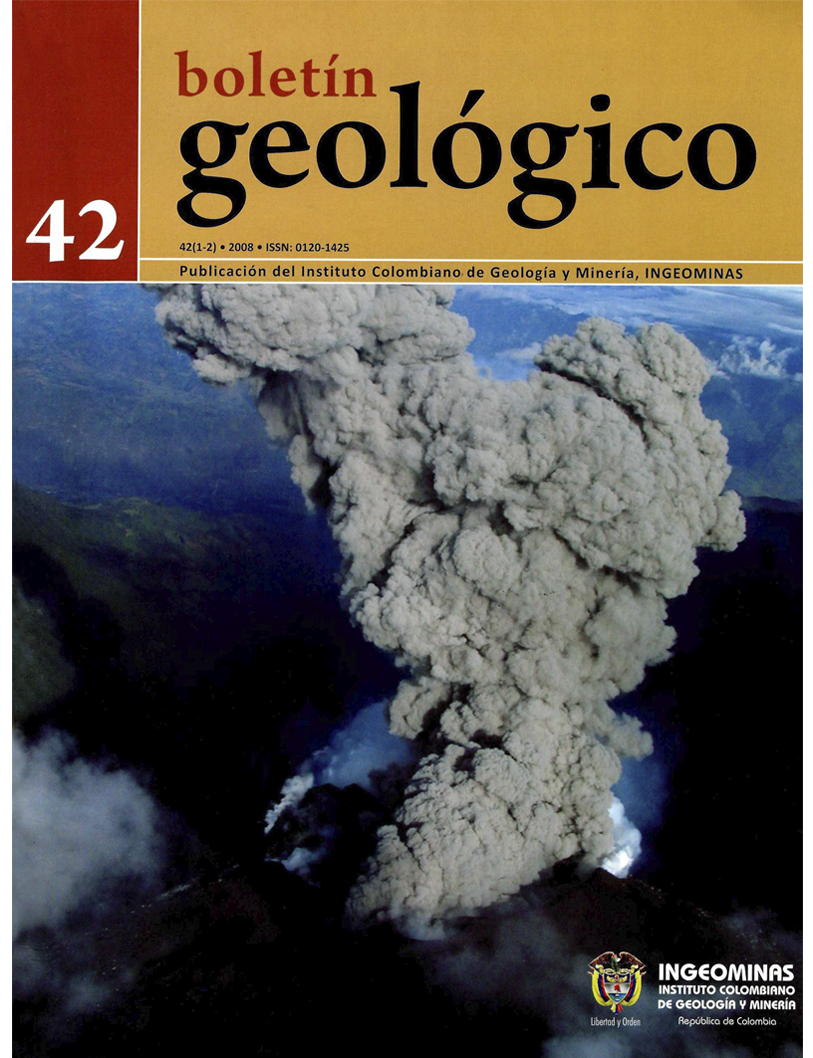Estudio hidrogeoquímico e isotópico en los acuíferos de la zona de Maicao, Colombia
DOI:
https://doi.org/10.32685/0120-1425/boletingeo.42.2008.20Keywords:
Sierra Nevada, section, granulites, anorthosites, granitesDownloads
How to Cite
Issue
Section
Published
Abstract
A combined hydrogeological study using hydrochemistry and environmental isotopes (deuterium, oxygen 18, tritium, carbon 13, and radiocarbon) has been completed in the region of Maicao (Colombia). The study area encompasses 650 km2 and includes three aquifers: the Cretaceous Aquifer (limestones), south of the Oca fault, the Tertiary Aquifer (semi-consolidated marine sediments) and the Quaternary Aquifer (unconsolidated sediments of continental and marine origins). Both the Quaternary and Tertiary aquifers are located just to the north of the same fault (elevation between 40 and 600 m above sea level). The Quaternary Aquifer is an unconfined aquifer underlain by the Mongui Formation (a confined Tertiary Aquifer). Lts regional groundwater flow is northward. The climatic conditions are semiarid, with an average temperature of 27 C, annual average precipitation of 350 mm in the north and 1200 mm in the south (September to November). Two types of groundwater have been found in Maicao: the first, low salinity and young (less than 50 years), is located in the Cretaceous Aquifer and in the sector of the Quaternary Aquifer adjacent to the Carraipia River (main superficial water body in the project area), the second, moderately mineralized, isotopically depleted with respect to the first group and older (more than 7900 years), is located in the Tertiary Aquifer and in the central and northern sectors of the Quaternary Aquifer. Results of this study show that the recharge of the Quaternary Aquifer which is the aquifer most extensively used by the inhabitants of Maicao is slow and is, therefore, susceptible to depletion if no measures are taken to insure rational use.
References
Álvarez, O. (1994). Análisis de los resultados de la perforación y construcción del pozo Carraipía 9.
Bürgl, H. (1960). Geología de la península de la Guajira. Bol. Geol., 61 129-168.
Bürgl, H. (1961). Historia geológica de Colombia. Rev. Acad. Colomb. Cienc. Exact. Pis. Nat., 11(43), 137-191.
Bürgl, H. (1967). Toe orogenesis in the Andean system of Columbia. Tectonophysics, 4(4-6), 429-443.
Consultores del Caribe Ltda. (2002). Plan de Ordenamiento Territorial, municipio de Maicao, La Guajira: Consolidado de los aspectos ambientales, parte II, p.63.
Huguett Granados, A. (1988). Resumen del Estudio Hidrogeológico de la Media y Baja Guajira. Boletín Geológico, 29(1), 45-83. Bogotá: INGEOMINAS.
Ingeominas. (1999). Resultados de la ejecución de la prueba de bombeo en los pozos del acueducto de Maicao, departamento de La Guajira.
Jousma, G. & Serrano, S. (1980). Investigación hidrológica de la Media y Baja Guajira. Bol. Geol., 23(3).
Mesa, O. J., Poveda, G. & Carvajal L. F. (1997). Introducción al clima de Colombia. Bogotá: Universidad Nacional de Colombia.
Poveda, G. (2004). La Hidroclimatología de Colombia: una síntesis desde la escala interdecadal hasta la escala diurna. Rev. Acad. Colomb. Cienc. Exact. Pis. Nat., XXVIII(107), 202-220.
Radelli, L. (1962). Acerca de la geología de la serranía de Perijá entre Codazzi y Villanueva (Magdalena-Guajira, Colombia). Geología Colombiana, 1, 23-P
Thomas, D. & Mac Donald, W (1976). Summary of Tertiary Stratigraphy and Structure, Guajira Península. In Etayo-Serna and Cáceres-Girón (Eds.), Primer Congreso Colombiano de Geología.
Toro, L. E. (2003). Informe preliminar perforación pozo de observación P37, corregimiento Majayura, Maicao. Informe Interno Corpoguajira.
Toro, L. E. (2004). Estimación de la velocidad horizontal en pozos de observación en el municipio de Maicao. Primeros resultados. Documento interno de Corpoguajira.
Ujueta, G. & Llinás, R. (1990). Reconocimiento geológico de la parte mas septentrional de la serranía de Perijá. Geología Colombiana, 17, 197-209.
Wokittel, R. (1957). Bosquejo Geográfico y Geológico de la Sierra Nevada de Santa Marta y la Serranía de Perijá. Bol. Geol., 5(3), 29-49.









